Townsend C.R., Begon M., Harper J.L. Essentials of Ecology
Подождите немного. Документ загружается.


acceptable standard of living. The higher estimates come closer to the concept
of a carrying capacity we normally apply to other organisms (see Chapter 5) – a
number ‘imposed’ by the limiting resources of the environment. But it is unlikely
that many of us would choose to live crushed up against an environmental ceiling
or wish it on our descendants.
In any case, it is a big step to assume that the human population is limited
‘from below’ by its resources rather than ‘from above’ by its natural enemies.
Infectious disease in particular, which not long ago was considered to be an
enemy largely vanquished, is now once again perceived, for example by the
World Health Organization, as a major threat to human welfare. Just consider
the growing epidemics in tuberculosis and HIV and AIDS and the deaths caused
by malaria. We saw in Chapter 7 that many infectious diseases thrive best in the
densest populations.
Any suggestions we make about a global carrying capacity clearly depend on
choices we make both for ourselves and for others. Most of us would choose to
live at least as well as we do at present, but can the global population afford to
choose for the whole world to live at least as well as those in developed countries
do now? The answer to any question depends on what is meant by the question –
defining what we mean by ‘the global carrying capacity’ is far from straightforward.
12.3 Harvesting living resources from
the wild
A major limit to the number of people the Earth can support is the food that
can be obtained. Populations of many species living freely in the wild are exploited
for food by humans, who ‘cull’ or ‘harvest’ a proportion of the population,
leaving some individuals behind to grow and reproduce for future harvests.
Primitive human societies obtained all their resources like this, by hunting and
gathering from nature, and humans continue to garner some resources in this
way. The resources may be fish from the sea, deer from a moorland or timber from
a forest. There is an important difference between resources obtained in this
way and those that are farmed (Sections 12.4 and 12.6). Farmed resources are
obtained by taking chosen species of plant or animal, domesticating them (often
changing them genetically) and growing or rearing them in more or less con-
trolled monocultures. These resources tend to be owned and managed by a farmer
or organization. In contrast, most of the oceans and forests that are fished and
hunted have at one time been common property, open to free-for-all unsustain-
able looting by all-comers. Recently, though, fishing and hunting have also come
under increasing national and international regulation and national claims to
‘ownership’. Many of our examples in this section are of fish or fisheries, but the
principles apply to the harvesting of any natural resource.
12.3.1 Fisheries: maximum sustainable yields
Whenever a natural population is exploited there is a risk of overexploitation:
too many individuals are removed and the population is driven into biological
jeopardy or economic insignificance – perhaps even to extinction. Global catches
of marine fish rose five-fold between 1950 and 1989 and many of the world’s fish
Chapter 12 Sustainability
399
aiming for the narrow path
between over- and
underexploitation
9781405156585_4_012.qxd 11/5/07 15:01 Page 399

Part IV Applied Issues in Ecology
400
Underdeveloped
Developing
Fully exploited
Overexploited
Crashed
1950 1960 1970 1980 1990 2000
20
40
60
80
100
0
Stock (%)
Year
Figure 12.5
Changes in the contribution to global marine fish production made by
fisheries in different phases of their exploitation. In the 1950s most
of the catches were from undeveloped fisheries, but by 2000 most
fisheries were fully exploited (near their maximum sustainable yield),
or overexploited or had already collapsed.
AFTER KHAN ET AL., 2006
Net recruitment
Population size
population dynamics in the
absence of exploitation –
humped net recruitment curves
stocks are now beyond the point of overexploitation (Figure 12.5). But harvesters
also want to avoid underexploitation: if fewer individuals are removed than the
population can bear, the harvested crop is smaller than necessary, potential con-
sumers are deprived and those who do the harvesting are underemployed. It is not
easy to tread the narrow path between under- and overexploitation. It is asking
a great deal of a management policy to combine the well-being of the exploited
species, the profitability of the harvesting enterprise, continuing employment for
the workforce and the maintenance of traditional lifestyles, social customs and
natural biodiversity.
The most fundamental aspects of ecology that we need to understand here
were introduced in Chapter 5 when the effects of intraspecific competition on
populations were discussed. To determine the best way to exploit a population,
it is necessary to know what the consequences will be of different exploitation
‘strategies’. But in order to know these consequences, we first need some under-
standing of the dynamics of the population in the absence of, or prior to, exploita-
tion. It is usual to assume that, before it is exploited, a harvestable population is
crowded and intraspecific competition is intense. Summarizing from Chapter 5,
and remembering that these are broad generalizations:
l
populations in the absence of exploitation can be expected to settle around
their carrying capacity, but exploitation will reduce numbers to less than this;
l
exploitation, by reducing the intensity of competition, moves the population
‘leftwards’ along the humped net recruitment curve, increasing the net
number of recruits to the population per unit time (Figure 12.6).
Figure 12.6
The humped relationship between the net
recruitment into a population (births minus
deaths) and the size of that population, resulting
from the effects of intraspecific competition
(see Chapter 5). Population size increases from
left to right, but increasing rates of exploitation
take the population from right to left.
9781405156585_4_012.qxd 11/5/07 15:01 Page 400

In fact, we can go further with Figure 12.6, since it is clear from the shape of
the curve that there must be an ‘intermediate’ population size at which the rate of
net recruitment is highest. Consider a time scale of years. The peak of the curve
might be ‘10 million new fish recruited each year’. This is then also the highest
number of new fish that could be removed from the population each year that the
population itself could replenish. It is known as the maximum sustainable yield
(MSY): the largest harvest that can be removed from the population regularly
and indefinitely. It looks as though a fishery could tread the narrow path between
under- and overexploitation if the fishers could find a way to achieve this MSY.
The MSY concept has been the guiding principle in resource management for
many years in fisheries, forestry and wildlife exploitation, but it is very far from
being the perfect answer for a variety of reasons.
1 By treating the population as a number of similar individuals, it ignores
all aspects of population structure such as size or age classes and their
differential rates of growth, survival and reproduction.
2 By being based on a single recruitment curve, it treats the environment
as unvarying.
3 In practice, it may be impossible to obtain a reliable estimate of the MSY.
4 Achieving an MSY is by no means the only, nor necessarily the best,
criterion by which success in the management of a harvesting operation
should be judged. (It may, for example, be more important to provide
stable, long-term employment for the workforce.)
12.3.2 Obtaining MSYs through fixed quotas
There are two simple ways of obtaining an MSY on a regular basis: through
a ‘fixed quota’ and through a ‘fixed effort’. With fixed quota MSY harvesting
(Figure 12.7), the same amount, the MSY, is removed from the population every
year. If (and it is a big if) the population stayed exactly at the peak of its net
recruitment curve, then this could work: each year the members of the popula-
tion, through their own growth and reproduction, would add exactly what the
harvesting removed. But if by chance numbers fell even slightly below those
at which the curve peaked, then the numbers harvested would exceed those
recruited. Population size would then decline to below the peak of the curve,
Chapter 12 Sustainability
401
MSY – the narrow path?
the MSY concept has
shortcomings
Population density
N
m
h
h
h
m
h
h
h
m
K
Recruitment or
harvesting rate
Recruitment rate
Harvesting rate
the fragility of fixed quota
harvesting...
Figure 12.7
Fixed quota harvesting. The figure shows a single recruitment curve
(solid line; recruitment in relation to density, N) and two fixed quota
harvesting curves (dashed lines): high quota (h
h
), and MSY quota
(h
m
). The arrows in the figure refer to changes to be expected in
abundance under the influence of the harvesting rate to which the
arrows are closest. The black dots indicate equilibria. At h
h
the only
‘equilibrium’ is when the population is driven to extinction. The MSY
is obtained at h
m
because it just touches the peak of the recruitment
curve (at a density N
m
): populations greater than N
m
are reduced to
N
m
, but populations smaller than N
m
are driven to extinction. K is the
carrying capacity, the density where the population is expected to
settle in the absence of exploitation.
9781405156585_4_012.qxd 11/5/07 15:01 Page 401
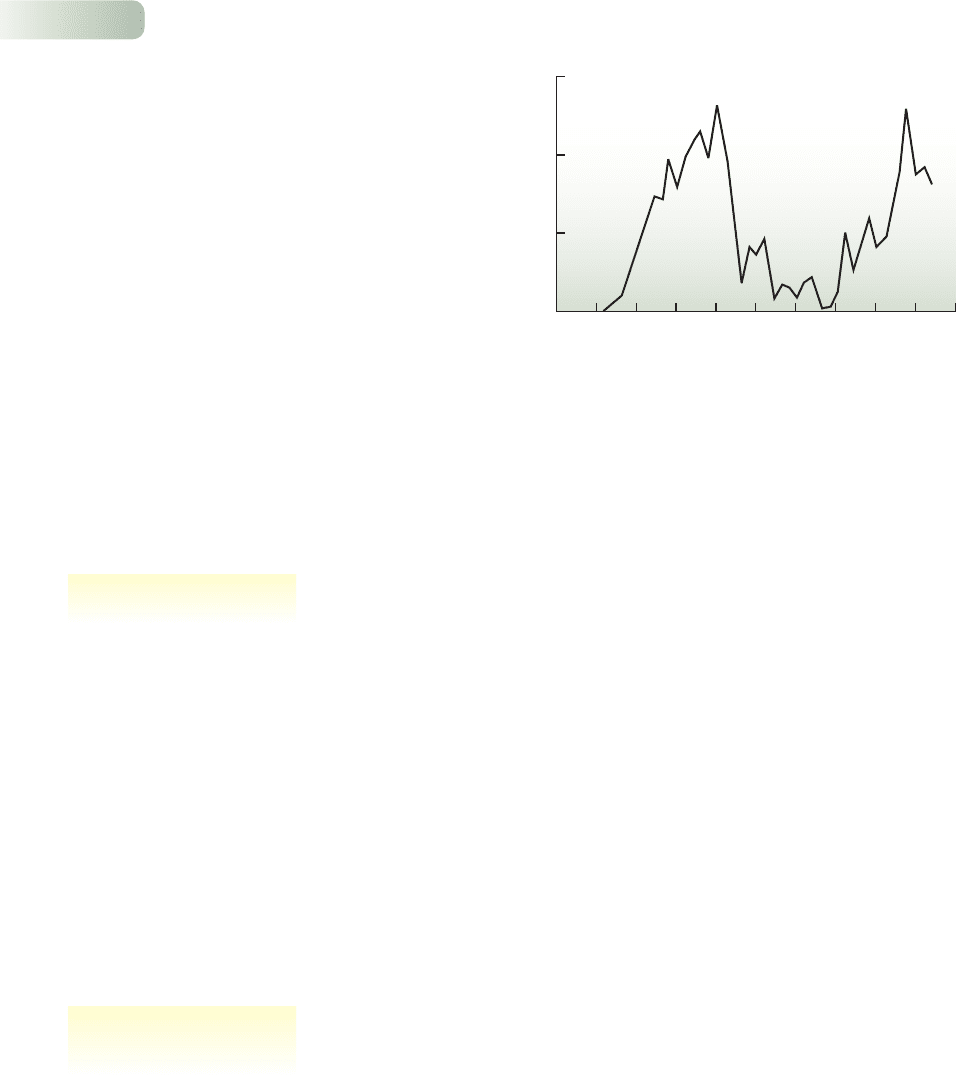
and if a fixed quota at the MSY level were maintained the population would
carry on declining until it was extinct (Figure 12.7). Furthermore, if the MSY
was even slightly overestimated (and reliable estimates are hard to come by) then
harvesting rate would always exceed the recruitment rate and extinction would
again follow. In short, a fixed quota at the MSY level might be desirable and
reasonable in a wholly predictable world about which we had perfect knowledge.
But in the real world of fluctuating environments and imperfect data sets, these
fixed quotas are open invitations to disaster.
Nevertheless, a fixed quota strategy has frequently been used – a management
agency formulates an estimate of the MSY, which is then adopted as the annual
quota. On a specified day in the year, the fishery is opened and the accumulated
catch is logged. A fairly typical example is provided by the Peruvian anchovy
(Engraulis ringens) fishery (Figure 12.8). From 1960 to 1972 this was the world’s
largest single fishery, and it constituted a major sector of the Peruvian economy.
Fisheries experts advised that the MSY was around 10 million tonnes annually,
and catches were limited accordingly. But the fishing capacity of the fleet expanded,
and in 1972 the catch crashed. Overfishing seems, at the least, to have been a major
cause of the collapse, although its effects were compounded with the influences
of profound environmental fluctuations, discussed below. A moratorium on
fishing would have been an ecologically sensible step, but this was not politically
feasible: 20,000 people were dependent on the anchovy industry for employment.
The Peruvian government therefore allowed fishing to continue. The stock took
more than 20 years to recover.
12.3.3 Obtaining MSYs through fixed effort
An alternative to trying to maintain a constant harvest is to maintain a constant
‘harvesting effort’ (e.g. the number of ‘trawler-days’ in a fishery or the number of
‘gun-days’ with a hunted population). With such a regime the amount harvested
should increase with the size of the population being harvested (Figure 12.9).
Now, in contrast to Figure 12.7 if density drops below the peak, new recruit-
ment exceeds the amount harvested and the population recovers. The risk of
extinction is much reduced. The disadvantages, however, are first, because there
is a fixed effort, the yield varies with population size (there are good, but, more
to the point, bad years), and second, steps need to be taken to ensure that nobody
makes a greater effort than they are supposed to. Nonetheless, there are many
Part IV Applied Issues in Ecology
402
Landings (million tonnes)
15
10
5
0
Year
20001995199019851980197519701965196019551950
Figure 12.8
Landings of the Peruvian anchovy since 1950. Note the dramatic
crash that resulted mainly as a result of overfishing. The stock has
taken 20 years to rebuild.
AFTER JENNINGS ET AL., 2001
. . . borne out in practice
relative robustness of fixed
effort harvesting
9781405156585_4_012.qxd 11/5/07 15:01 Page 402
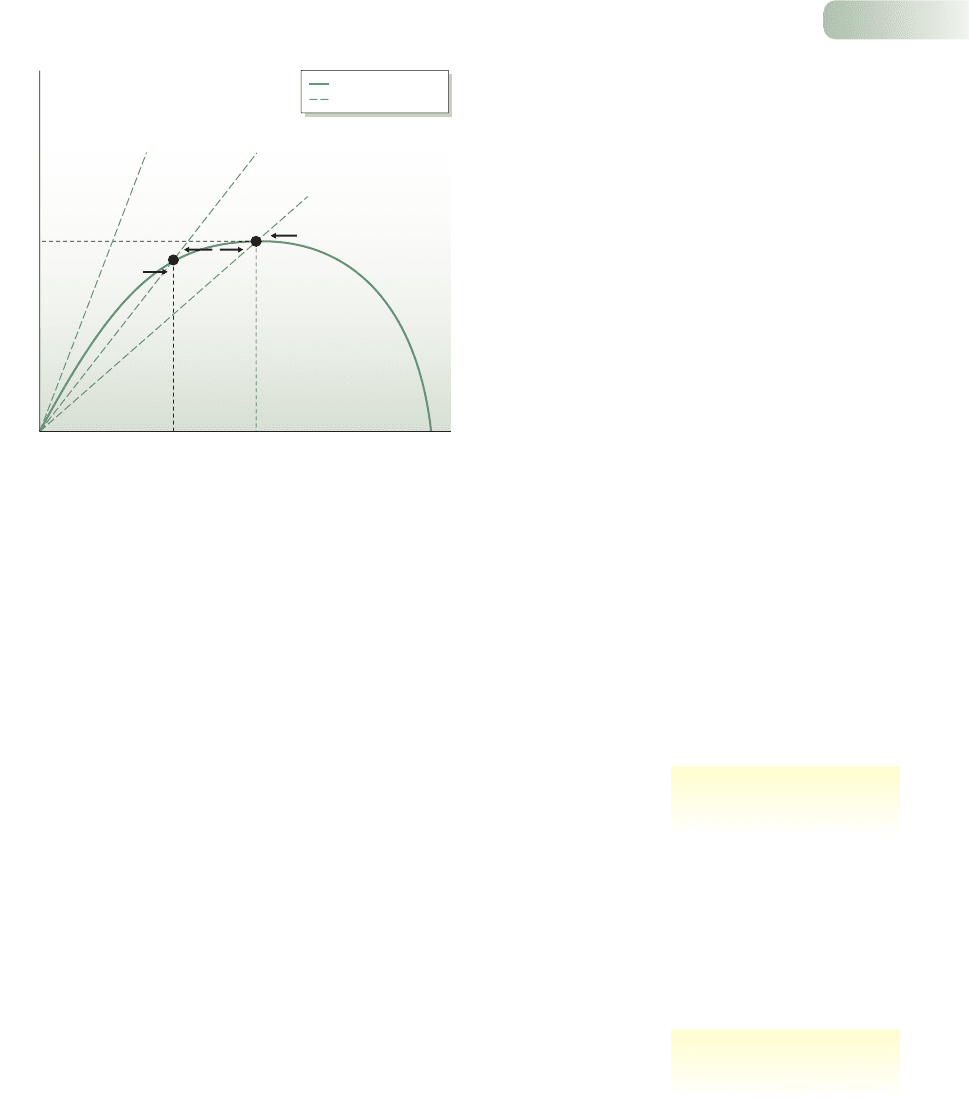
examples of harvests being managed by legislative regulation of effort. Harvesting
of the important Pacific halibut (Hippoglossus stenolepis), for example, is limited
by seasonal closures and sanctuary zones, though heavy investment in fisheries
protection vessels is needed to control law breakers.
12.3.4 Beyond MSYs
There is no doubt that fishing pressure often exerts a great strain on populations.
But the collapse of fish stocks in one year rather than any other is often the result
of an occurrence of unusually unfavorable environmental conditions, rather than
simply overfishing.
Harvests of the Peruvian anchovy (see Figure 12.8) collapsed from 1972 to
1973, but a previous steady rise in catches had already dipped in the mid-1960s
as a result of an El Niño event: this happens when warm tropical water from the
north reduces the upwelling, and hence the productivity, of the nutrient-rich cold
Peruvian current coming from the south. By 1973, however, commercial fishing
had so greatly increased that the subsequent El Niño event had even more severe
consequences. There were some signs of recovery from 1973 to 1982, but a
further collapse occurred in 1983 associated with yet another El Niño event. It is
unlikely that the El Niño events would have had such severe effects if the anchovy
had only been lightly fished. It is equally clear, though, that the history of the
Peruvian anchovy fishery cannot be explained simply in terms of overfishing.
So far, this account has ignored population structure of the exploited species.
This is a bad fault for two reasons. First, most harvesting practices are primarily
interested in only a portion of the harvested population (mature trees, fish that
are large enough to be saleable, etc.). Second, ‘recruitment’ is, in practice, a
complex process incorporating adult survival, adult fecundity, juvenile survival,
juvenile growth and so on, each of which may respond in its own way to changes
in density and harvesting strategy. An example of a model that takes some of
these variables into account was that developed for the Arcto-Norwegian cod
fishery, the most northerly fish stock in the Atlantic Ocean. The numbers of fish
Chapter 12 Sustainability
403
Population density
E
0
E
h
E
m
Recruitment rate or harvesting rate
N
m
N
h
h
m
Recruitment rate
Harvesting rate
Figure 12.9
Fixed effort harvesting. Curves, arrows and dots as in Figure 12.7.
The MSY is obtained with an effort of E
m
, leading to a stable
equilibrium at a density of N
m
with a yield of h
m
. At a somewhat
higher effort (E
h
), the equilibrium density and the yield are both
lower than with E
m
, but the equilibrium is still stable. Only at a
much higher effort (E
0
) is the population driven to extinction.
environmental fluctuations – the
anchovy and El Niño
population structure and the
Arctic cod (Gadus morhua)
9781405156585_4_012.qxd 11/5/07 15:01 Page 403
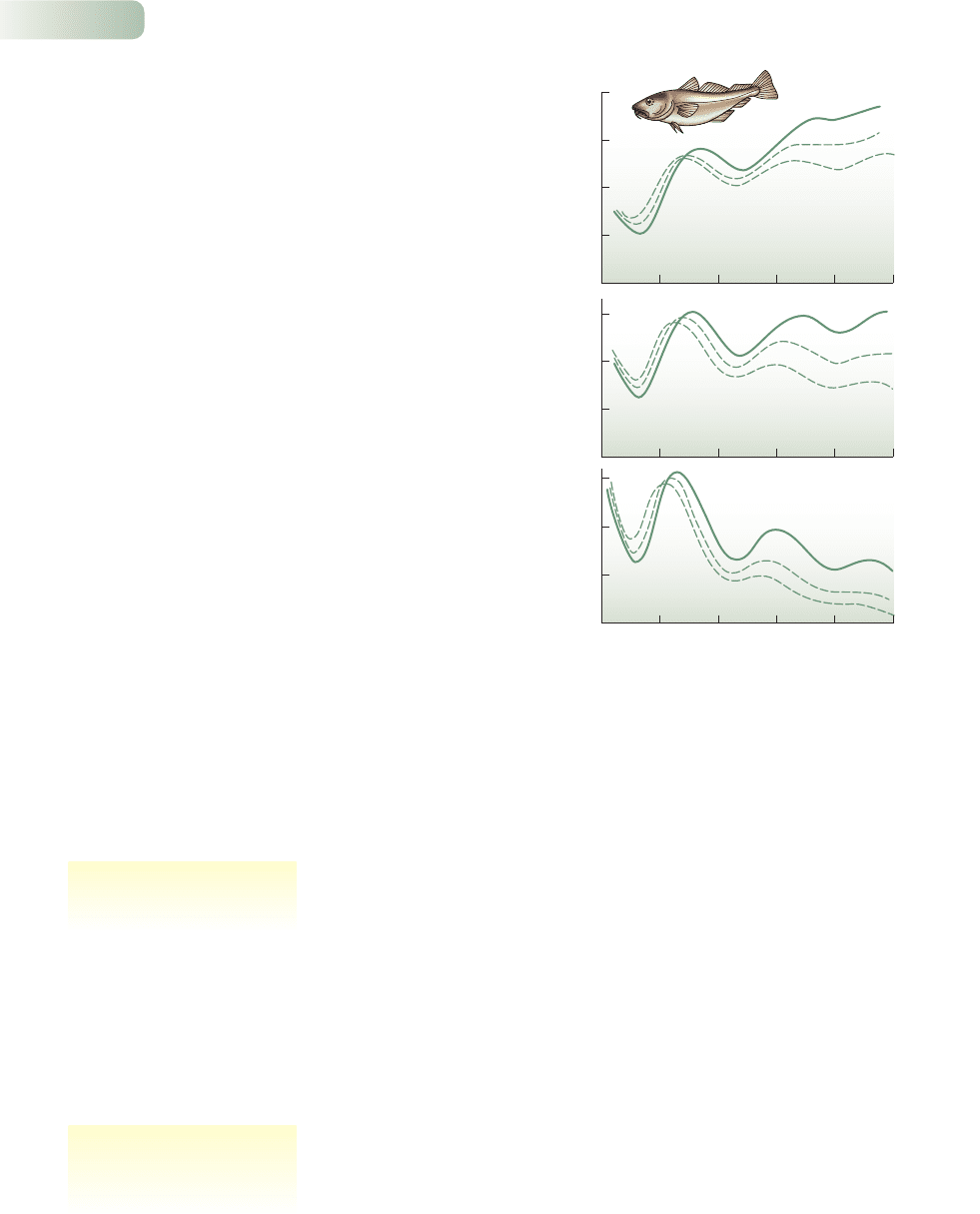
in different age classes were known for the late 1960s and this information was
used to predict the tonnage of fish likely to be caught with different intensities of
harvesting and with different net mesh sizes. The model predicted that the long-
term prospects for the fishery were best ensured with a low intensity of fishing (less
than 30%) and a large mesh size. These gave the fish more opportunity to grow
and reproduce before they were caught (Figure 12.10). The recommendations from
the model were ignored and, as predicted, the stocks of cod fell disastrously.
Indigenous harvesters have long had their own ‘regulations’ to reduce the chance
of overexploitation. In their harvesting of moi (Polydactylus sexfilis), Hawaiian
fishermen, using traditional methods along the shore, take only intermediate-sized
fishes, leaving both juveniles and large females. Thus they go a stage further than
simply increasing net mesh size, which, while reducing the numbers of smaller
individuals taken, nevertheless captures the largest individuals in the population.
The good sense of the Hawaiian strategy has been reinforced by the discovery
that large females of some fish not only produce exponentially more offspring
but also that each of their offspring grows faster (Figure 12.11) and is more likely
to reach adulthood. Protecting the largest individuals may give a great boost to
sustainability.
Managing most marine fisheries to achieve perfect, optimum yields is an unattain-
able dream. There are generally too few researchers to do the work and, in many
parts of the world, no researchers at all. In these situations, a precautionary
approach to fisheries management might involve locking away a proportion of a
coastal or coral community in marine-protected areas (Hall, 1998). The term
Part IV Applied Issues in Ecology
404
800
600
400
200
0
Catch (thousand tons)
600
400
200
0
600
400
200
0
5010152025
Mesh sizes
Years of this regime
160 mm
145 mm
130 mm
160 mm
145 mm
130 mm
160 mm
145 mm
130 mm
Fishing intensity
26%
Fishing intensity
33%
Fishing intensity
45%
Figure 12.10
Predictions for the stock of Arctic cod under three intensities of fishing
and three different sizes of mesh in the nets. Larger meshes allow more
and larger fish to escape capture. The largest effort (45%, bottom panel)
is clearly unsustainable, regardless of the mesh size used. The largest
sustainable catches are achieved with a low fishing effort (26%, upper
panel) and a large mesh size.
AFTER PITCHER & HART, 1982
a strategy of taking only
intermediate-sized fishes
precautionary management,
closed areas and ‘data-less’
management
9781405156585_4_012.qxd 11/5/07 15:01 Page 404
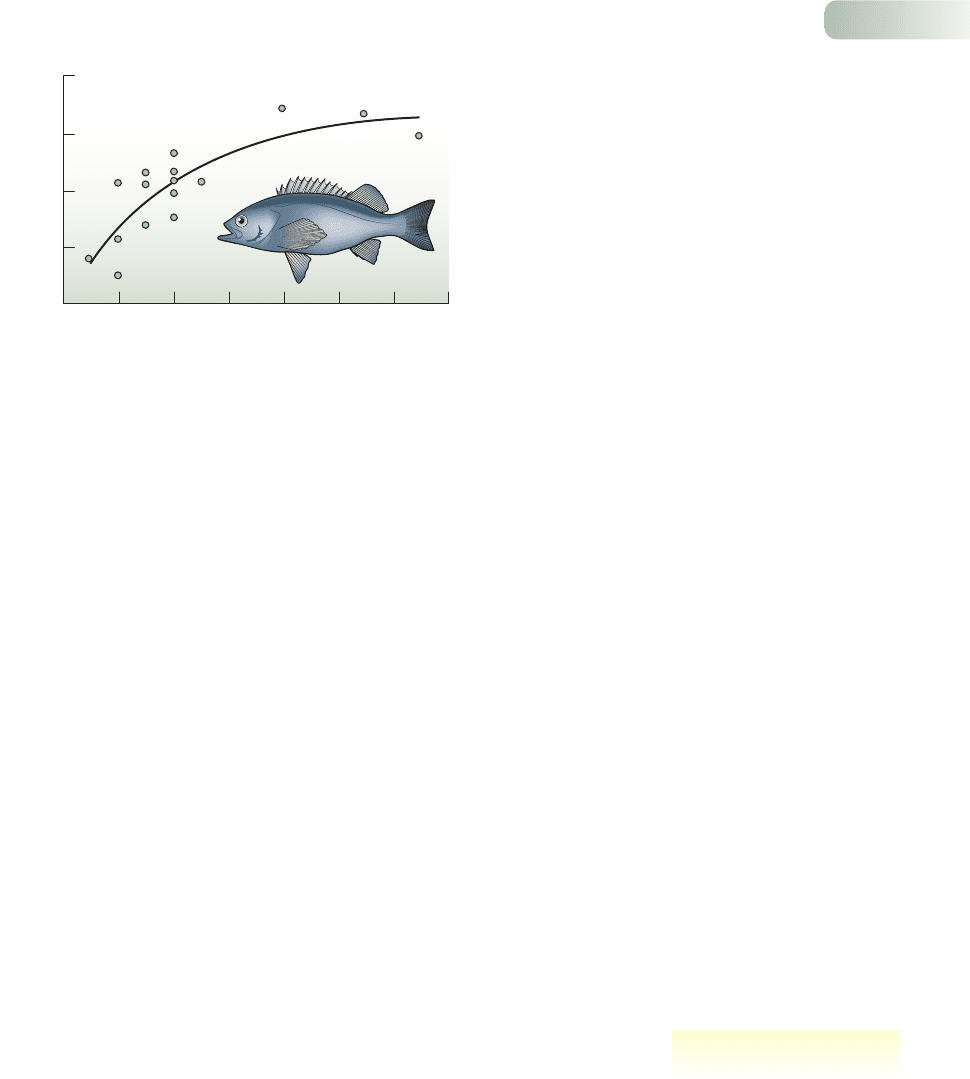
data-less management has been applied to situations where local villagers follow
simple prescriptions to make sustainability more likely – for example locals on the
Pacific island of Vanuatu were provided with some simple principles of manage-
ment for their trochus (Tectus niloticus) shellfishery: stocks should be harvested
every 3 years and left unfished in between. The outcome has apparently been
successful: continued economic viability (Johannes, 1998).
12.4 The farming of monocultures
Globally there is abundant food. Between 1961 and 1994 the per capita food
supply in developing countries increased by 32% and the proportion of the
world’s population that was undernourished fell from 35% to 21%, though this
is very unevenly distributed. Yet 800 million people remain hungry worldwide,
and the rate of increase in per capita food production is falling.
Fishing and hunting (Section 12.3) have been human activities since our early
history as hunter-gatherers. But the harvest that can be taken from nature was
totally inadequate to support the main phases of growth of human populations.
Increasingly, both animals and plants were domesticated and managed in ways
that allowed much greater rates of production. The great bulk of the human food
resource is now farmed – usually produced as dense populations of single species
(monocultures). This allows them to be managed in specialized ways that can
maximize their productivity, whether as immense monocultures of rice, corn or
wheat (Figure 12.12), or as livestock factories producing beef, pork or poultry.
Fish, indeed, are increasingly managed in the same way (aquaculture) – reared in
enclosures, fed with controlled diets and harvested in mass production. Nearly a
quarter of the fish supply in Asia is already produced in this way.
Only monoculture can maximize the rate of food production. This is because
it allows the farmer to control and optimize with high precision the density of the
populations (livestock or crop plants), the quantity and quality of their resources
(food supplied to livestock; fertilizer and water to the crops) and often even the
physical conditions of temperature and humidity. With many animals, the mono-
cultures extend to segregating livestock or poultry into narrow age bands or age
classes. If the only important criteria are economic ones, then there need be
none of the uneconomic mixing of calves with cows or chickens with hens; fish
eggs and fry can be segregated from potentially cannibalistic adults; the grossly
Chapter 12 Sustainability
405
AFTER BOBKO & BERKELEY, 2004
0.08
0.06
0.04
0.02
0
4 6 8 10 12 14 16 18
Maternal a
g
e (years)
Growth in length (mm day
–1
)
Figure 12.11
The black rockfish (Sebastes melanops), off the coast of Oregon,
USA, is a long-lived fish that produces live young. Not only do
bigger fish produce more eggs to be fertilized, but the proportion
of these that are in fact fertilized is itself greater in larger females.
Futhermore, as shown in the graph, larvae produced by older
(larger) females grow more than three times as fast as do larvae
produced by their younger (smaller) counterparts.
monoculture – and beyond
9781405156585_4_012.qxd 11/5/07 15:01 Page 405
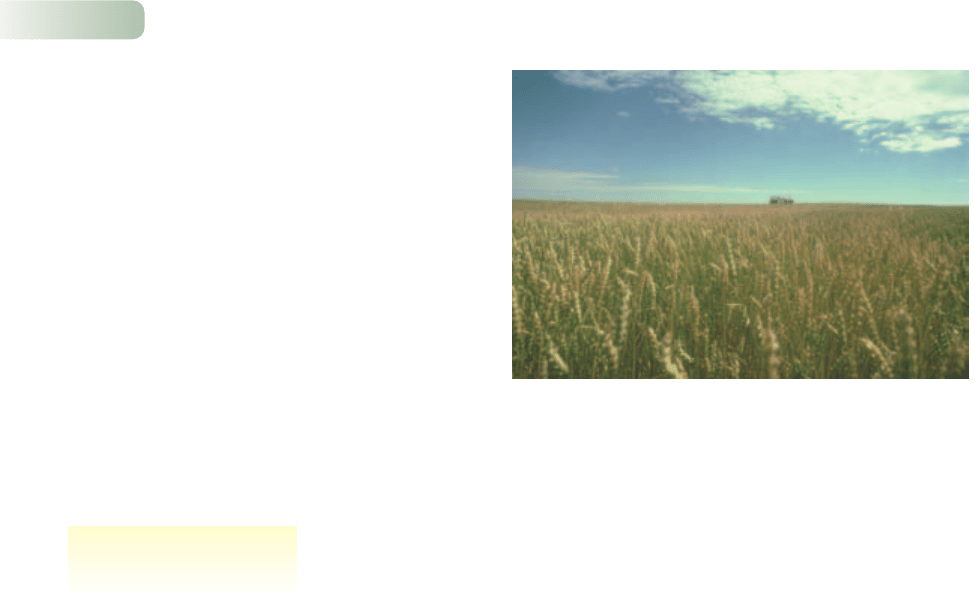
uneconomic equality of the sex ratio that is common in nature can be distorted
by culling to give efficient all-female dairy herds of cattle, or all-hen populations
in batteries for egg production. This is a far cry from the ecology of the primitive
human hunter-gatherers, who subsisted on their gleanings from the tangled web
of wild nature!
To what extent, though, are modern farming methods sustainable? There
is abundant evidence that a high price has to be paid to sustain the high rates of
food production achieved by farmed monocultures. For example, they offer ideal
conditions for the epidemic spread of diseases such as mastitis, brucellosis and
swine fever among livestock and coccidiosis among poultry. Farmed animals
are normally kept at densities far higher than their species would meet in nature
with the result that disease transmission rates are magnified (see Chapter 7). In
addition, high rates of transmission between herds occur as animals are sold
from one farming enterprise to another, and it is easy for the farmers themselves,
with mud on their boots and their vehicles, to act as vectors of pests and disease.
The dramatic spread of foot and mouth disease in 2001 among British livestock
provides a graphic example.
Crop plants, too, provide illustrations of the fragility of human dependence on
monocultures. The potato, for example, was not introduced across the Atlantic to
Europe until the second half of the 16th century, but three centuries later other
foods had given way to it, and it had become the almost exclusive food crop of the
poorer half of the population of Ireland. Dense monoculture, though, provided
ideal conditions for the devastating spread of late blight (the fungal pathogen
Phytophthora infestans) when it also crossed the Atlantic in the 1840s. The disease
spread rapidly, dramatically reducing potato yields and also decomposing the tubers
in storage. Out of the Irish population of about 8 million, 1.1 million died in the
resulting famine and another 1.5 million emigrated to the UK and the USA.
In more modern history, an outbreak of southern corn leaf blight (caused
again by a fungus, Helminthosporium maydis) developed in southeastern USA
in the late 1960s and spread rapidly after 1970. Most of the corn grown in the
area had been derived from the same stock and was genetically almost uniform.
This extreme monoculture allowed one specialized race of the pathogen to have
devastating consequences. The damage was estimated as at least $1 billion in the
USA and had repercussions on grain prices worldwide. One of our favorite fruits
is also at great risk of economic disaster (Box 12.3).
Part IV Applied Issues in Ecology
406
Figure 12.12
Agricultural monoculture:
wheat as far as the eye
can see.
but disease spreads in
monocultures
9781405156585_4_012.qxd 11/5/07 15:01 Page 406

12.4.1 Degradation and erosion of soil
A United Nations report (1998) stated:
Agricultural intensification in recent decades has taken a heavy toll on the
environment. Poor cultivation and irrigation techniques and excessive use of
pesticides and herbicides have led to widespread soil degradation and water
contamination.
Around 300 million hectares are now severely degraded around the world and
a further 1.2 billion hectares – 10% of the Earth’s vegetated surface – can be
described as moderately degraded. Clearly much of agricultural practice has not
been sustainable.
Land without soil can support only very small primitive plants such as lichens
and mosses that can cling onto a rock surface. The rest of the world’s terrestrial
Chapter 12 Sustainability
407
12.3 TOPICAL ECONCERNS
12.3 Topical ECOncerns
In June 2005, Dan Koeppel filed the story below.
For nearly everyone in the US, Canada and
Europe, a banana is a banana: yellow and sweet,
uniformly sized, firmly textured, always seedless.
The Cavendish banana – as the slogan of
Chiquita, the globe’s largest banana producer,
declares – is ‘quite possibly the world’s perfect
food’. . . . It also turns out that the 100 billion
Cavendish bananas consumed annually worldwide
are perfect from a genetic standpoint, every
single one a duplicate of every other. It doesn’t
matter if it comes from Honduras or Thailand,
Jamaica or the Canary Islands – each Cavendish
is an identical twin to one first found in Southeast
Asia, brought to a Caribbean botanic garden in
the early part of the 20th century, and put into
commercial production about 50 years ago.
That sameness is the banana’s paradox. After
15,000 years of human cultivation, the banana is
too perfect, lacking the genetic diversity that is
key to species health. What can ail one banana
can ail all. A fungus or bacterial disease that
infects one plantation could march around the
globe and destroy millions of bunches, leaving
supermarket shelves empty.
A wild scenario? Not when you consider that
there’s already been one banana apocalypse.
Until the early 1960s, American cereal bowls
and ice cream dishes were filled with the Gros
Michel, a banana that was larger and, by all
accounts, tastier than the fruit we now eat. Like
the Cavendish, the Gros Michel, or ‘Big Mike’,
accounted for nearly all the sales of sweet
bananas in the Americas and Europe. But
starting in the early part of the last century, a
fungus called Panama disease began infecting
the Big Mike harvest.
(All content © 2005 Popular Science. A Time4 Media
Company. All rights reserved. Reproduction in whole
or in part without permission is prohibited.)
1 Use a web search to discover the options that
might be used to safeguard the banana industry.
2 How far fetched do you consider the risk of global
economic terrorism by deliberate spread of a
banana disease?
Can this fruit be saved? The banana as we know it is on a crash
course toward extinction
9781405156585_4_012.qxd 11/5/07 15:01 Page 407
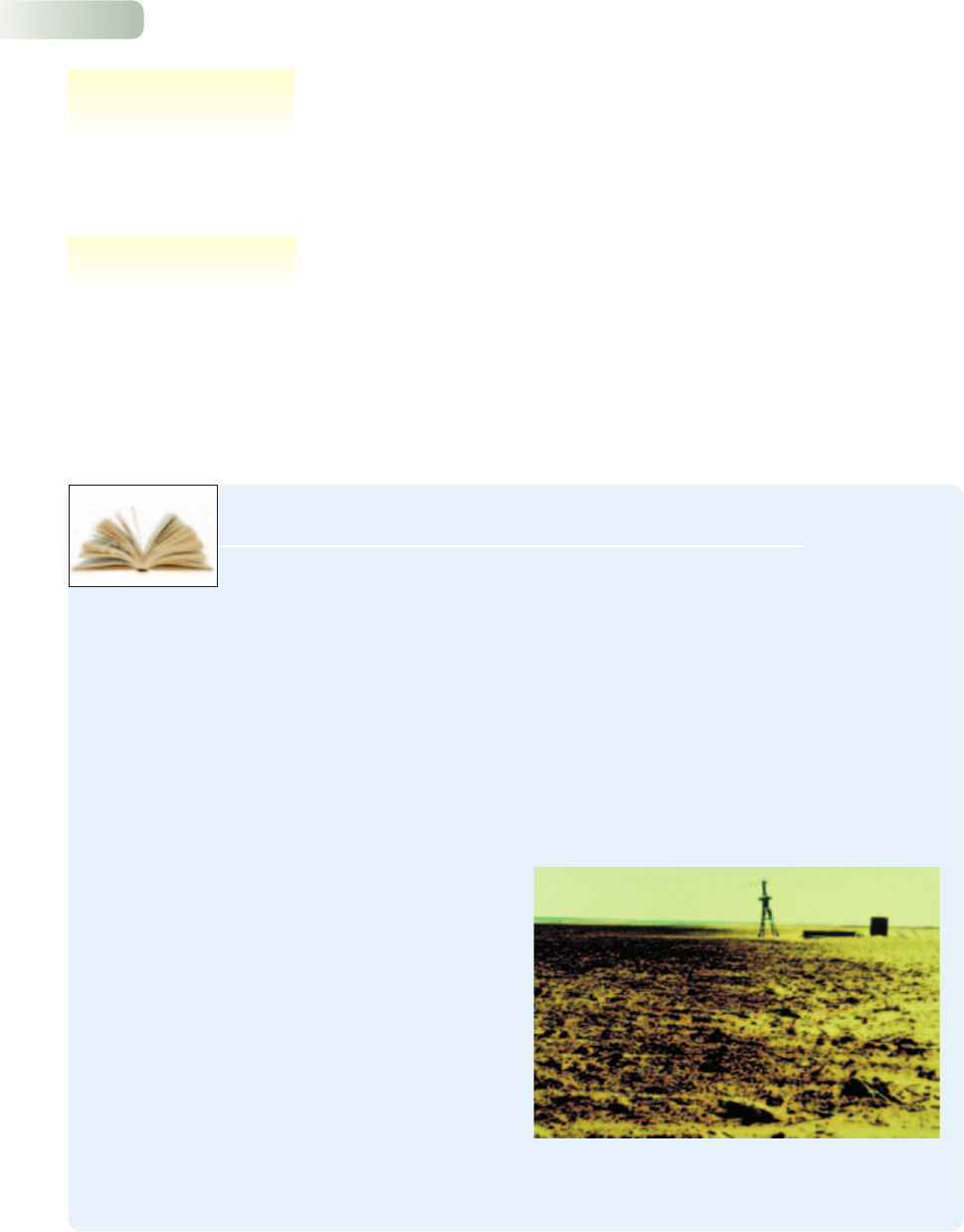
vegetation has to be rooted in soil, which gives it physical support. The soil also serves
as a store of essential mineral nutrients and water that are extracted by the roots
during plant growth. Soil develops by the accumulation of finely divided mineral
products of rock weathering and decomposing organic residues from previous
vegetation. The characteristics of the soil under natural vegetation in any particular
climatic region and on any particular rock type depends on the balance between
these processes of accumulation and forces that degrade and remove the soil.
The formation and persistence of soil in a region depend on local natural
checks and balances. Soil may be lost by being washed or blown away, perhaps
to be redeposited as an accumulation of fine-textured ‘loess’ somewhere else. Soil
is best protected when it contains organic matter, is always wholly covered with
vegetation, is finely interwoven with roots and rootlets and is on horizontal
ground. Natural soil systems are probably always too fragile to be fully sustained
when land is brought into cultivation. Dramatic evidence of unsustainable land
use came from the ‘dust bowl’ disaster in the Great Plains of the United States and
a similar disaster happening currently in China (Box 12.4).
Part IV Applied Issues in Ecology
408
soil forms...and is lost
12.4 HISTORICAL LANDMARKS
12.4 Historical landmarks
Large areas of southeastern Colorado, southwestern
Kansas and parts of Texas, Oklahoma and north-
eastern New Mexico were once used to support
rangeland management of livestock. The vegetation
consisted largely of native perennial grasses and had
been neither ploughed nor sown with seed.
At the time of the First World War, much of the land
was ploughed and annual crops of wheat were grown.
There were poor crops in the early 1930s due to severe
drought and the topsoil was exposed and carried
away by the wind. Black blizzards of windblown soil
blocked out the sun and piled the dirt in drifts. Occa-
sionally the dust storms swept completely across the
country to the East Coast. Thousands of families were
forced to leave the region at the height of the Great
Depression in the early and mid-1930s. The wind ero-
sion was gradually halted with federal aid: windbreaks
were planted and much of the grassland was restored.
By the early 1940s the area had largely recovered.
The story is being repeated today in northwest
China, where the need to feed 1.3 billion people has
led to the raising of too many cattle and sheep, and
the use of too many plows. This is more than the
land can stand and 2300 km
2
are turning to desert
each year. A huge dust storm blanketed areas from
Canada to Arizona in April 2001 – the dust originated
in China.
Soil erosion, America’s historical ‘dust bowl’ and
China’s current problem
Dust bowl field and abandoned farm.
© VISUALS UNLIMITED
agriculture and forestry
requires soil
9781405156585_4_012.qxd 11/5/07 15:01 Page 408
